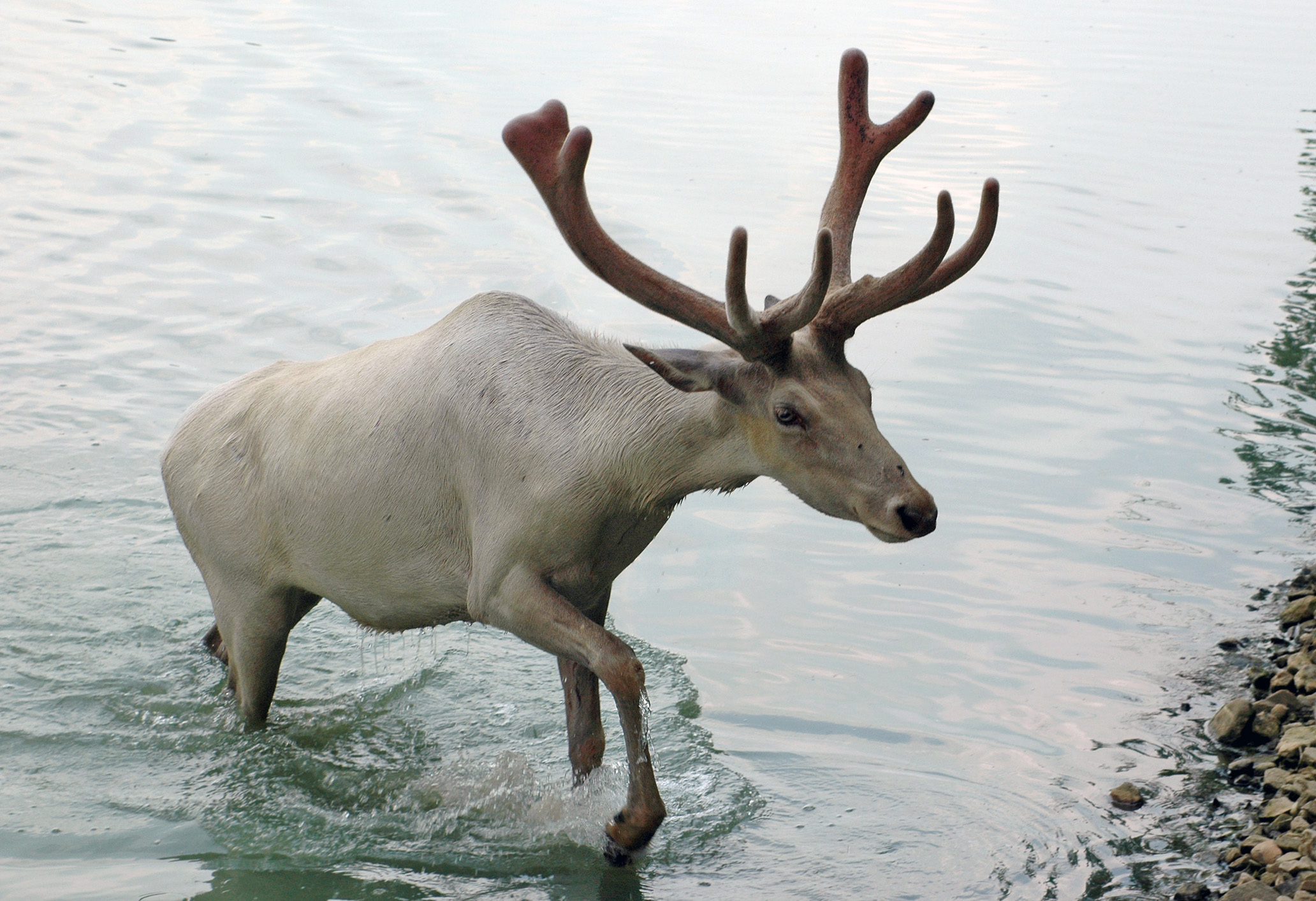- Barren-ground Caribou
Taxobox
name = ("albino") Barren-ground Caribou
status = LR/lc

image_width = 240px
regnum =Animal ia
phylum =Chordata
classis =Mammal ia
subclassis =Theria
ordo =Artiodactyla
familia =Cervidae
subfamilia = Odocoilinae
genus = "Rangifer "
species = "R. tarandus"
subspecies = "R. tarandus groenlandicus"
subspecies_authority = (Linnaeus, 1767)
binomial = "Rangifer tarandus groenlandicus"
binomial_authority = (Linnaeus, 1767)Barren-ground Caribou ("Rangifer tarandus groenlandicus") are a
subspecies of caribou that are found mainly in the Canadian territoriesNunavut and theNorthwest Territories and westernGreenland . They are medium sized caribou with the females 90 kg (198 lb) and the males 150 kg (331 lb). However, on some of the smaller islands, the average weight may be less.Like the
Peary Caribou , both the males and females haveantler s. In general, during the summer, the coat of the caribou is brown, and much lighter in the winter. The neck and rump tends towards a creamy-white colour. However, the general colouration may differ depending on the region.The barren-ground caribou usually breeds in the fall and calves in June but may not drop their single calf until July. Usually the female will give birth away from the herd and if possible on a patch of snow. After birth, the female will lick the calf clean and eat the tissues and the
placenta . This may serve two purposes, first to replace nutrients lost from birthing and second to help remove the scent that would attract predators.The main food source is
lichen but they will also feed onCyperaceae (sedges) and other grasses along with twigs andmushroom s. Caribou have also been observed to eat antlers, seaweed and will lick salt deposits. There is some evidence to suggest that on occasion they will also feed onlemming s,arctic char and bird eggs.On the mainland of Canada, the animals may travel in herds of several thousand but on the islands, they move in smaller groups (no more than 50). They are migratory animals and may travel 1,200 km (746 mi) in a season. Some groups, such as those living on Victoria Island during the summer, will migrate to the mainland in the fall time after the sea ice has formed. At this time, the smaller groups may form into a larger herd and several hundred animals may be seen. Mainland barren-ground caribou herds move to coastal areas for part of each year, with the exception of the Beverly Herd. [cite web |url=http://209.85.173.104/search?q=cache:zcC6ALKtmXAJ:www.taiga.net/projectcaribou/pdf/casestudies/beverly_study.PDF+thelon+wildlife&hl=en&ct=clnk&cd=7&gl=us |title=The Beverly Caribou Herd: Continental Wilderness Travellers |publisher=taiga.net |accessdate=2008-01-16] The Beverly Herd (located primarily in Saskatchewan, Northwest Territories; portions in Nunavut, Manitoba, Alberta) and the Qamanirjuaq Herd (located primarily in Manitoba, Nunavut; portions in southeastern NWT, northeastern Saskatchewan) fall under the auspices of the Beverly and Qamanirjuaq Caribou Management Board. [cite web |url=http://www.arctic-caribou.com/aboutcaribou.html |title=The caribou herds |publisher=arctic-caribou.com |accessdate=2008-01-16]The barren-ground caribou, called "tuktu" in
Inuinnaqtun /Inuktitut , and written as "ᓇᐹᕐᑐᕐᑲᓐᖏᑦᑐᒥ ᑐᒃᑐ" inInuktitut syllabics , is a major food source for theInuit , especially theCaribou Inuit bands living in theKivalliq Region ("Barren Lands") of present-dayNunavut . [cite web |url=http://www.amazon.com/Walking-Land-Farley-Mowat/dp/1586420240/ref=sr_1_5?ie=UTF8&s=books&qid=1198536516&sr=1-5 |title=Walking on the Land |publisher=amazon.com |accessdate=2007-12-24]The major predator of Barren-ground caribou is the
arctic wolf who may follow the herd for many miles. The caribou has poor eyesight and hearing but is capable of outrunning the wolf.References
* [http://www.natureserve.org/explorer/servlet/NatureServe?searchName=Rangifer+tarandus+groenlandicus NatureServe]
*Terrestrial Mammals of Nunavut by Ingrid Anand-Wheeler. ISBN 1-55325-035-4
*IUCN2006|assessors=Deer Specialist Group|year=1996|id=29742|title=Rangifer tarandus|downloaded=18 June 2006See also
*
Reindeer hunting in Greenland External links
* [http://www.nwtwildlife.com/NWTWildlife/caribou/description.htm Barren-ground Caribou]
* [http://www.hww.ca/hww2.asp?id=85 Hinterland Who's Who]
* [http://www.arctic-caribou.com/index.html Beverly and Qamanirjuaq Caribou Management Board website]
** [http://www.arctic-caribou.com/range_map.html Map of the Beverly and Qamanirjuaq caribou range]
Wikimedia Foundation. 2010.
